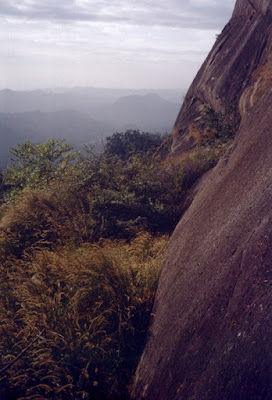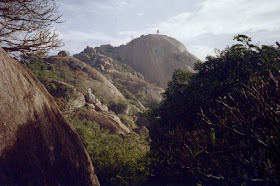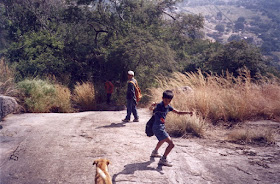Savandurga is a sprawling rock formation. This was one of the important forts during Kempegowda's time and also Tipu's time. The fort walls cover a vast area. Savandurga fort can be divided into three parts- Karigudda, Biligudda and Basavana Durga. Karigudda translated to black-hill, this is more or less a bare rock with some vegetation at the top and eastern face. The summit of Karigudda is the highest point of Savandurga. Biligudda means white-hill, this hill is rocky but covered with vegetation excepting its bare summit. Basavana Durga is a collection of plateau and slopes. This hill is frequently visited by elephants.
That's Gulveer with Biligudda in the background. This picture was taken some time 1995 from Basava Mantapa on Karigudda summit. I think it was our second visit.
This is the gateway to Biligudda fort.
Part of the fort wall on the slope.
This few yards of rock is quite steep and slippery. We sat and slid on our butts. That's Basu in the foreground.
Karigudda's comes into view as the path passes through the valley. The speck on the summit is Basava Mantapa, also called Nandi Mantapa.
This part of the path passes through gaps between rocks.
This stretch is through boulders, trees, roots and branches. Rain water has washed of dirt between rock leaving them loose. We had to watch every step.
Passage through a natural tunnel in rocks. We had to cross a 12 feet long, 10 feet deep ditch, the bridge was a half-foot wide log. The only support we had was a rock face which was not really close. One fall could leave few broken bones.
Basu and Rohin wait on the other side of the passage.
A natural rock-shelter. Our four-legged friend always stayed with us. I'm wondering how it crossed the log bridge, looks like none of noticed it.
We reached a plateau, the top of the sheer rock face we passed by earlier. A grand view of Biligudda, Basava Mantapa is seen clearly now. We did not see anyone up there.
It was quite windy, had to be careful not to lose balance. Smart thing do is sit or lie down as our friend did.
Basu is fighting wind :)
A huge pit. Probably a natural one with some modifications by human hands. Kiran is actually squatting on a narrow stretch. Barely two feet behind him is a 60 feet drop. He's brave to sit there with wind blowing like crazy.
We spent about 30 minutes trying to figure out a way forward. We had one option but it was too steep and we weren't carrying any ropes. We decided not to risk safety. We rested a while before beginning our return journey. Basu amused himself by flying a plastic bag kite with a thread.
We took the same path down. A grassy stretch, even the ground was covered with grass, very slippery and blind to ditches. One of my steps landed into a ditch toppling me.
At the end end of the grassy stretch is this slope. This few yards of rock is quite steep and slippery. Basu dancing out of joy, he really enjoyed this trek. So did the others. That's the magic of Savandurga.
A word of caution- its good to climb this hill in a large group, with at least one person familiar with the trail. Large groups have a tendency to get noisy, do not disturb the peaceful ambiance. Most importantly climb during daylight and descend while its still bright.
.........





















Basu thumps up for you. He seems to be passionate about nature.
ReplyDeleteBeautiful scenery. I miss hillock.
I was looking at erroneous references to Karigudda and Biligudda online and came across this blog entry.
ReplyDeleteCould you double-check? Because I think in the beginning you refer to the correct names, and later mess it up. It's a slip and not intentional, I am assuming.
Thank you Shreshth for letting me know of the error. I've edited the post, could you check once please.
Delete